The software change returned error code 1603
Troubleshooting application installations in SCCM 2012 R2 can seem daunting but it really isn’t. You just need to know where to look. A common error a lot of folks receive is “The software change returned error code 1603” and also “Process terminated with exit code 1603“. The first indication of a problem can be found in the Software Center of the client in question. When you open the System Center Configuration Manager 2012 Software Center and attempt to install the application it fails with a generic error “Unable to make changes to your software” or “The software change returned error code 0x643(1603)“. Of course the error code will be different depending on the issue. The first question you MUST answer is whether the software package in question is failing to install on ALL or just some clients. Chances are that if the package is failing to install on ALL your clients, then something is most likely wrong with the installation package. This may not always be true but the probability is high that it is. However, if the package is being successfully deployed and installed on many clients but failing on others, then use the steps below to troubleshoot why SCCM is failing to install your application successfully.
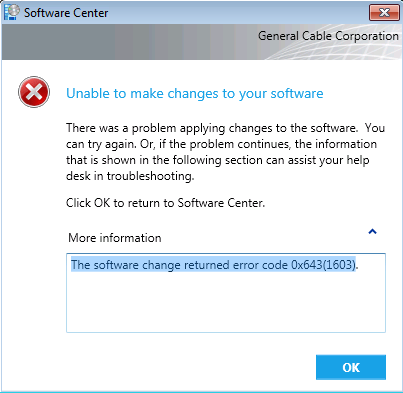
SCCM has a ton of logs, sometimes I think they may have too many! Depending on what you are troubleshooting, will determine what logs you should be reviewing. In this blog post, we are troubleshooting application installation failures. There are two main logs that I use when troubleshooting application failures; Execmgr.log and AppEnforce.log. The SCCM client logs can be found in the following directory of each client’s local hard drive; c:\Windows\CCM\Logs\. The following Technet site has everything you need to know about the purpose of every SCCM log file and what it contains. If you want to be an expert on troubleshooting SCCM issues, check out https://technet.microsoft.com/en-us/library/hh427342.aspx.
The Execmgr.log contains detailed information regarding the installation packages that run on all SCCM clients. Sometimes the information in this log may not make sense or get you going in the wrong direction if you are not careful. In the example below, note the error “Failed to open WMI namespace“. When you perform a Google search on this error, you’ll notice several articles regarding WMI corruption. However, in this example, that was NOT my problem. I only bring this up to point out that it is important to investigate multiple logs to try and piece together your particular scenario. Sometimes the Execmgr.log might have some useful information so I think it is worth always looking at. At the very least, I know there is something that SCCM doesn’t like about this particular package trying to install on this particular client.
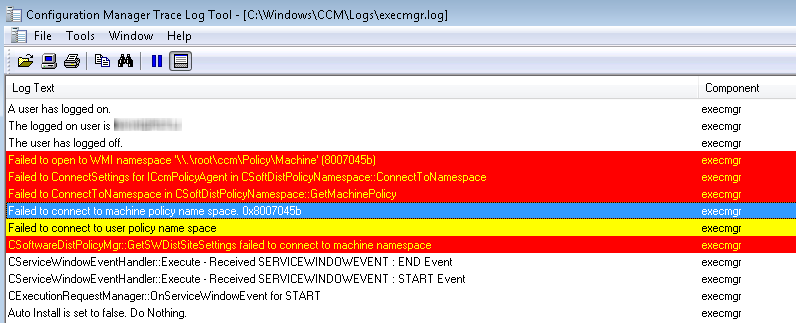
The AppEnforce.log contains very detailed information about the Install or Uninstall of the package. This is where you notice specific error codes regarding the installation of your software package. In the example below highlighted in Yellow, this package failed to install on my client and recorded error, “Unmatched exit code (1603) is considered an execution failure“. We already know that the SCCM package is fine but for some reason it is unable to successfully install on this client. Further down in the log, it will give you the exact installation file and all its parameters. In the example below, we can see the command is “AdobeSetup.msi /q /qn” highlighted in Green. A few lines down, note the location of the MSI (C:\Windows\ccmcache\sr).
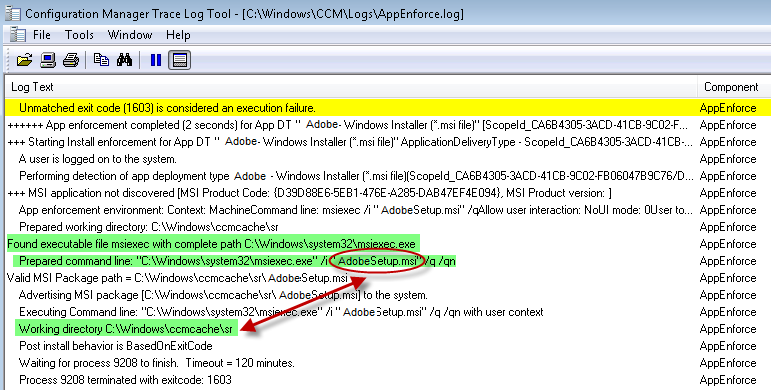
One way to troubleshoot why this package isn’t installing is to log onto the client computer that is experiencing the problem and navigate to the location of the MSI (C:\Windows\ccmcache\sr) and run the AdobeSetup.msi command without the /q parameter so that you can see why the application is failing. When I did this, on the client computer, I found that this particular client was missing a specific version of the .Net framework. So I installed the .Net framework it needed and let SCCM retry the installation of the package and it worked.
Of course there are other ways to tackle this problem. One thing that you should probably always do is when building the SCCM package, is to set the logging flag and log the installation details so that all you need to do is open that log file and view the results. I’ll leave that for another time.
Hope this helped someone. If so, be sociable and leave a comment! Thank you.

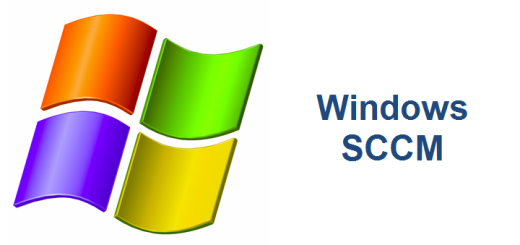
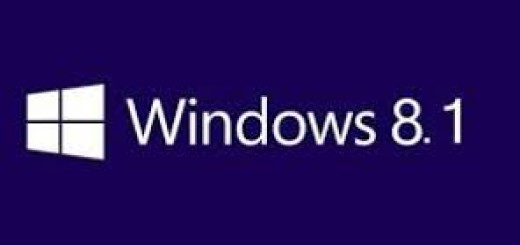
Hi George,
I tried by uninstalling the security software and deployed , but no luck same error.
No error in log.
Please suggest any idea.
Regards,
Anil
Anil, I’m not sure what you mean when you stated, “uninstalling the security software and deployed”. If you are receiving an error 1603 from the SCCM Software Center then you need to open the AppEnforce.log located in the c:\Windows\CCM\Logs\ directory on the local computer that is having the error. Then search for the 1603 error code and find the executing command that is failing. Then open a command prompt on the computer and try running that command manually. It should fail but you should receive some additional information that should help you diagnose your issue. I hope this helps.
i don’t see any error on execmgr.log except below one. Execution Request not found for the supplied MTC Task id: {34007BC1-75AE-4013-8F6C-D0979C in AppEnforce.log AdvertisePackage – MsiAdvertiseProduct Failed : 0x80070643 AppEnforce 7/2/2015 1:26:10 PM 4968 (0x1368) AdvertisePackage failed (0x80070643). AppEnforce 7/2/2015 1:26:10 PM 4968 (0x1368) Lowright users might fail to install this application if it requires higher privileges AppEnforce 7/2/2015 1:26:10 PM 4968 (0x1368) Executing Command line: “C:\WINDOWS\system32\msiexec.exe” /i “Nuance_PDFConverterEnterprise_8.2_ENU_R2.msi” /q /qn with user context AppEnforce 7/2/2015 1:26:10 PM 4968 (0x1368) Working directory C:\WINDOWS\ccmcache\l AppEnforce 7/2/2015 1:26:10 PM 4968 (0x1368) Post install behavior is BasedOnExitCode AppEnforce 7/2/2015 1:26:10 PM 4968 (0x1368)… Read more »
Interesting. On the surface it looks like it might be a permissions issue but you stated that it only is happening on one PC. I’ll have to research this one a little further.
Yes. User already installed and uninstalled the software, this caused to install again from Application catalog. now I have installed manually from cache folder.
in ths case, we need check AppDiscovery.log
Excellent! Thanks for posting the resolution!
I followed your instructions and I get error 1334 The file natives_blob.bin cannot be found in data1.cab. I searched for the file and I cannot find it in any of the downloads. where can I get this file or is there a work around for this?
Lucia, I’m going to assume you are deploying Adobe DC via SCCM. This blog post was about troubleshooting the failure of an SCCM package which apparently you’ve done. The error you mentioned seems specific to the Adobe install. Check out the Adobe article below. I will also email you as well. Good luck and thank you for your comments.
https://helpx.adobe.com/creative-suite/kb/install-error-1311-1335-or.html
Thank you, this helped me get started on troubleshooting SCCM software install failures.
Bez, thank you for leaving a comment. I’m happy this post helped you out.
I’m getting this error too “The software change returned error code 0x643(1603)” could it be because a newer version of the software is installed already? and if so how do I filter on that?
Wighty, so sorry for the delay, I was dealing with a major problem with one of my blogs. To answer your question, YES, it can be failing if your package isn’t detecting the previous version correctly. You can troubleshoot this manually. Have you looked at the AppEnforce.log? It contains very detailed information about the Install or Uninstall of the package. You should notice the specific error code/s regarding the installation of your software package and a little further down in the log, it will give you the exact installation file and all its parameters. And a little further below it… Read more »
Hello,
thanks for your help
I have installed my app manually, now how can we know the reason behind the failure, my case is exactly as yours, what could be the solution to solve the SCCM
thanks,
Ayham
Ayham, thanks for posting. It probably isn’t anything wrong with your package or SCCM if the package is successfully installing on other computers. Is your package installing successfully on other computers? The way to easily find out what went wrong is to take the installation command that is in the AppEnforce.log and run it manually on the failing computer or computers BUT WITHOUT THE /Q (QUIET) switch. See the paragraph in the blog post below: One way to troubleshoot why this package isn’t installing is to log onto the client computer that is experiencing the problem and navigate to the… Read more »
Hello,
thanks for your help
I have installed my app manually, now how can we know the reason behind the failure, my case is exactly as yours, what could be the solution to solve the SCCM
thanks,
Ayham
Nothing like a 1603 to ruin your day. My go to reaction is go look in appwiz.cpl (Control Panel gizmo for Install/Uninstall) and see if the offending thing is installed already, or maybe an older version. As is the case sometimes with Adobe Flash Player. In either case if it isn’t there or even if it is I then open the registry and search for Adobe Flash Player, anything found in Installer, Products (or maybe Product), and even at times Uninstall I delete.I then go back to Software Center and click Install and BAM! It installs without issue. This might… Read more »
Thanks for sharing your thoughts. Many times the issue is an older version of the package already installed and for one reason or another the SCCM package is not properly able to uninstall the existing application cleanly. Glad you were able to deploy your package.
George,
Thanks for the article. Fatal error is kind of Nightmare for me. Thanks again for the solution. It works well
Thanks for commenting Prajith. I’m glad it helped.
Hi George. Thanks for the helpful troubleshooting information. In my situation, error 1603 was because the MSI installed said ‘a newer version of this application is installed’. However, the SCCM detection method was not working, because the product codes between the 2 versions of the software were different… Therefore SCCM detected the SW as NOT installed, launched the silent install, and this silently failed due to windows installer detecting a newer version. To resolve this, i simply removed the newer version of the SW in Programs and Features, and then updated policy on the computer, and SCCM installed it’s version.… Read more »
Roger, thanks for commenting and posting your solution. I’m glad the post was helpful. Cheers!
Thanks for pointing me in the right direction. The application that I was trying to silently deploy had a EULA acceptance check within. Once I figured it out I was able to get it to silently install.
Just FYI the application that I was trying to install was PowerBI and the command line for silent install I used was “msiexec.exe /i “PBIDesktop_2.39.4526_x64.msi” /qn /norestart ACCEPT_EULA=1″
Sach, I’m happy that you were able to figure it out. Have a great rest of your weekend and thank you for posting your comments.
Hey, at first: nice tutorial how to troubleshoot SCCM ! I’ve deployed Adobe Reader… because of errors i got, i deleted the deployment and the whole package. Now i add a complete new Adobe Package but when SCCM try to install it says 1603. I tested the installation like you said without /qn /norestart command from cache folder and i can see msiexec is searching for the old package that i already deleted. So, whats the error? At the moment where i was writing this comment, i had an idea: the earlier Installation was canceled at some point, maybe he… Read more »
Dennis, thanks for taking the time to comments and sharing your experience. I’m sure it will help others. It is common to find incomplete package deployments that for one reason or another got disrupted and never quite finished installing correctly. When this happens, the old deployment files are left on the server and start to take up a lot of space. Check out another one of our articles explaining how to deal with that scenario. Cheers!
https://www.georgealmeida.com/2014/09/sccm-inboxes-despoolr/
I recently came across this message and my issue was that there was Pending Windows Updates. After rebooting the machine, it started working. Just FYI.
Thanks for posting Anthony
George, I have packaged VS 2012 via configuration manager 2012 SP1. I then move over to the client to launch software center. VS 2012 shows as available and downloads to the client when install is selected, however when it finishes downloading and starts to install it fails with error code 1603. I have ran the application via cmd on the client from the ccmchache directory and it installs fine. Before packaging VS 2012 I set the executable to run as administrator. settings for the path is “vs_professional.exe” /q /AdminDeployment.xml /Product key xxxxx-xxxxx-xxxxx-xxxxx-xxxxx via programs tab in the packaging properties. I… Read more »
Jeremy, I apologize for the late response. Too much going on, the holidays, work, etc. I haven’t had any time to spend on this blog lately. At any rate I suggest going to one of the clients that is having this issue and run the package install manually. This should definitively tell you why the package is not installing. Log onto the client computer that is experiencing the problem and navigate to the location of the MSI (C:\Windows\ccmcache\sr) and run the package msi command without the /q parameter so that you can see why the application is failing. For example,… Read more »
Solution for the above error: check the C drive free space( if you are using VDI)
once you free up min 4 to 5 gb after that please retry at software center and it will works
Mostly it happening coz of the low disk space
Chris, thanks for commenting. In my case, it was not low disk space but that could definitely cause issues. SCCM takes a lot of disk space, especially if you do not keep up with regular maintenance.
Your Blog really helpful. thanks so much for this information.
Thank you for the kind words Iggy. I’m really happy the blog post was helpful.
Thank you GEORGE..
I got the same Error 1603 while deploying the application, but i followed your suggestion about navigating to the location of the msi (C:\Windows\ccmcache) and run the[Right click tools.msi] command so that i can see why the application is failing. When I did this, on the client computer, I found this particular client was missing .Net framework 3.5 version. So I installed it and it worked successfully.
Regards,
ABHAS KUMAR SAMAL
George, As i mentioned above, my problem is resolved. But i want ask u without going to install the .Net framework 3.5, is there any other way to resolve this error-1603. One more thing i want to know basically what is this error-1603 all about, and as you are saying that this is a fatal error/ major error .so i need to know more about it. Is this the only case where we can face this particular error or other case are there, where we might be face this error? Please be more specify about it. I am waiting for… Read more »
Abhas, the 1603 error is kind of a generic error code indicating that “something” went wrong with the installation of the software package. It is really up to you to pour through the logs to figure out what exactly the problem is. In your example, the pre-requisite of .Net framework3.5 was needed in order for your package to install. I hope this answers your question. Thank you!
Abhas, I’m happy that the post helped you troubleshoot your issue. Thank you for your comments!
George, Thank you for your comments.
Actually I want to know the other type of solution for this particular issue. Because you have mentioned above that there’s other way to solve this error. So could you please tell me about it?
Thanks .It was very useful, really got to know what are those logs for.